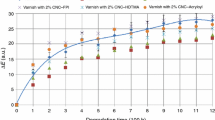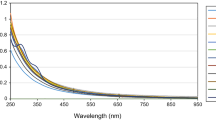Abstract
Condensed tannins, extractable from tree bark have been assessed as functional additives to provide a protective role to acrylic-based coating resins. In addition to retaining high antioxidant capacity, the UV absorption properties of native and chemically modified tannins were found to be variously impacted by pH and degree of esterification or etherification. When added to acrylic-based coatings, these tannins were found to contribute colour to a white-base, but only small perceptive differences were found for clear coated wood using typical additive loadings of 0.1–0.4%. Integration of tannins in native or modified form to do not inhibit the cure of acrylic coatings or found to leach from cured coating films. Accelerated weathering was used to evaluate the photo-stability of tannin-modified acrylic and styrene-acrylic coatings. Native and modified tannins with maleate or methylcarboxylate groups retaining high antioxidant activity were associated with significantly greater coating longevity and performance than use of a synthetic photostabiliser. Moreover, esterified condensed tannins with a high degree of substitution also outperformed synthetic additives indicating the inherent UV absorption potential of these materials also contributed this efficacy within the acrylic and styrene-acrylic coating systems.









Similar content being viewed by others
References
Mash A (2015) Sustainability in the Coatings Industry. PCI Magazine
Lligadas G et al (2013) Renewable polymeric materials from vegetable oils: a perspective. Mater Today 16(9):337–343
Tullo AH (2010) Paints from Plants: with biobased-coatings raw materials, companies get more than just independence from petroleum. Chem Eng News 88(15):16–19
Challener C (2010) The natural approach: Renewable resources in coatings. JCT CoatingsTech 7(9):42–47
Hayes DG, Dumont MJ (2016) Polymeric products derived from industrial oils for paints, coatings, and other applications, in Industrial Oil Crops. Elsevier Inc., Amsterdam, p. 43–73
Hare CH, Protective Coatings (1994) Fundamentals of chemistry and composition, edn. S.f.p. coatings. Technology Publishing Company, Pittsburgh
Grigsby WJ et al (2013) Esterification of condensed tannins and their impact on the properties of poly(lactic acid). Polymers 5(2):344–360
Grigsby WJ et al (2014) Evaluating modified tannin esters as functional additives in polypropylene and biodegradable aliphatic polyester. Macromol Mater Eng 299(10):1251–1258
Grigsby WJ, Bridson JH, Schrade C (2015) Modifying biodegradable plastics with additives based on condensed tannin esters. J Appl Polym Sci 132(11):41626
Hagerman AE (2002) Tannin Handbook ftp://217.148.94.129/: University of Miami, Ohio
Heim KE, Tagliaferro AR, Bobilya DJ (2002) Flavonoid antioxidants: chemistry, metabolism and structure-activity relationships. J Nutr Biochem 13(10):572–584
Hemingway RW, Karchesy JJ, Branham SJ (1989) The chemistry and significance of condensed tannins. Plenum Press, New York
Grigsby WJ (2016) Simulating the protective role of bark proanthocyanidins in surface coatings: Unexpected beneficial photo-stabilisation of exposed timber. J Org Coat. doi:10.1016/j.porgcoat.2017.03.007
Luo C et al (2010) Synthesis, characterization, and thermal behaviors of tannin stearates prepared from quebracho and pine bark extracts. J Appl Polym Sci 117(1):352–360
Arbenz A, Avérous L (2015) Chemical modification of tannins to elaborate aromatic biobased macromolecular architectures. Green Chem 17(5):2626–2646
Bridson JH (2007) Derivatisation of polyphenols, University of Waikato
Bridson JH, Grigsby WJ, Main L (2013) Synthesis and characterization of flavonoid laurate esters by transesterification. J Appl Polym Sci 129(1):181–186
Grigsby WJ, Kadla JF (2013) Evaluating poly(lactic acid) fiber reinforcement with modified tannins. Macromol Mater Eng 299:368–378
Gülçin I (2012) Antioxidant activity of food constituents: an overview. Arch Toxicol 86(3):345–391
Shukla S, Rai JSP (2014) Environmentally-friendly acrylates-based polymer latices. In Tiwari A, Syväjärvi M (eds) Advanced materials for agriculture, food and environmental safety. Wiley Blackwell, Hoboken pp 145–176
Monaghan G (2008) Environmentally advanced technology for semitransparent deck stains. JCT CoatingsTech 5(3):30–37
Tolvaj L, Mitsui K (2005) Light source dependence of the photodegradation of wood. J Wood Sci 51(5):468–473
Acknowledgements
This work was supported by Biopolymer Network Ltd, through funding by the New Zealand Ministry of Business, Innovation and Employment. The authors are thankful to the contributions of Jaime-Anne Elliot (UV spectra) for technical assistance.
Author information
Authors and Affiliations
Corresponding author
Electronic supplementary material
Below is the link to the electronic supplementary material.
Rights and permissions
About this article
Cite this article
Grigsby, W., Steward, D. Applying the Protective Role of Condensed Tannins to Acrylic-based Surface Coatings Exposed to Accelerated Weathering. J Polym Environ 26, 895–905 (2018). https://doi.org/10.1007/s10924-017-0999-0
Published:
Issue Date:
DOI: https://doi.org/10.1007/s10924-017-0999-0




